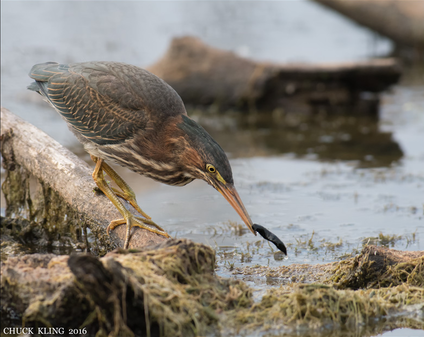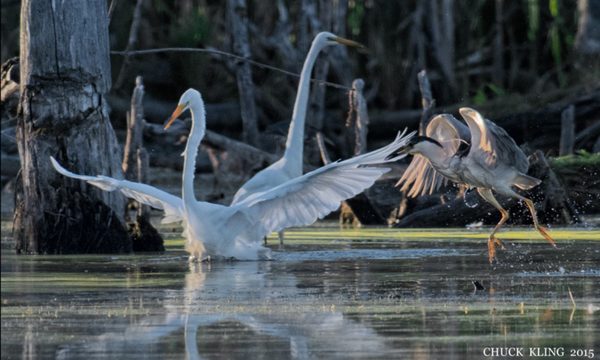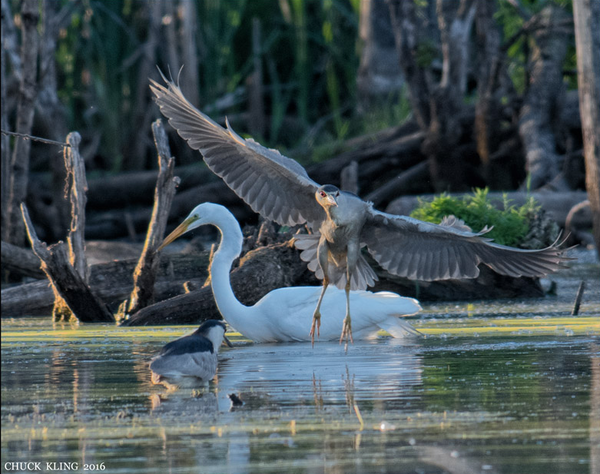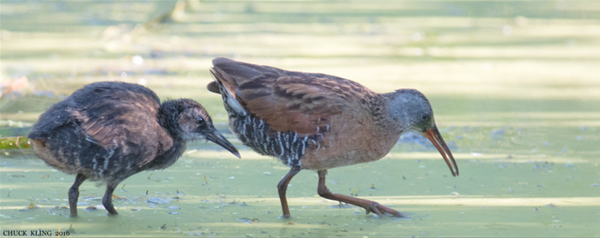
Blog by Deirdre King, Communication Committee member and former Board Member of the Sierra Club Canada Foundation
Imagine a wetland area that is home to over 80 nesting species including herons, raptors, songbirds and ducks. Then imagine it in the middle of a Technoparc on the Island of Montreal, a few miles west of downtown and just east of the Trudeau Airport.
“This area is unique,” says Joël Coutu, a leading Montreal bird expert with over thirty years experience, who leads bird fieldtrips in the Montreal area as well as around Lake Ontario and the Niagara region. What makes the area unique is a combination of habitats that is ideal for many species of birds. As the photos by CHUCK KLING of the birdlife in the Technoparc which accompany this blog demonstrate, this area is something very special.
The wetlands consist of three ponds, one that is swampier and with dead trees, which is ideal for heron. It hosts not just one but many species: Great Egret, Great Blue Heron, Black–crowned Night Heron and Green Heron. Such a variety of heron in one place is something that is not often encountered. In addition, there is another pond that is smaller and without dead trees that is ideal for species like the Least Bittern, which is a species listed as threatened under the Species at Risk Act. There is a third, deeper pond that is ideal for ducks such as the Green-winged Teal.
Top image: Green Heron, by Chuck Kling

Great Egrets and Black-crowned Night-heron, by Chuck Kling

Great Egret and Black-crowned Night-herons, by Chuck Kling
Lastly, the combination of woodland and prairie surrounding this wetland is ideal for other bird species such as the Sora, the Virginia Rail, many species of songbird including the Wood Thrush whose numbers are declining. The area is also host to many species of raptor: the Cooper’s Hawk, the Red-shouldered Hawk, the Red-tailed Hawk, the American Kestrel, the Merlin and the Northern Harrier.

Virginia Rails, adult and young, by Chuck Kling

Lesser Yellowlegs, by Chuck Kling
The variety of habitat and foodstuff for birds, from fish to small game to amphibians and reptiles, is what is attracting so many different species of birds in such numbers. One could call it a bird paradise. But there is trouble in paradise.
Construction is beginning on a new building project entitled the Campus Hubert-Reeves. The project, known as the Eco-Campus, because the buildings will be built to environmental standards, will consist of eight buildings, a parking lot and possibly the extension of an existing road. The fear is that the loss of habitat that will result as well as the noise of construction that is slated to last five years will mean that the birds will no longer come to the Technoparc wetlands.
The project may also adversely affect one of the nesting species in the wetlands, the Least Bittern, which is a small heron, which as mentioned above has been listed as threatened under the federal Species at Risk Act. There are a number of nesting pairs in the pond that is close enough to the area that will be under construction to be adversely affected.
Part of the project includes constructing a dike around the deepest of the three ponds that will be right next to the proposed Eco-Campus. The advisability of doing this is being questioned as attempts to control the water levels in wetlands often backfire and the changes that may result could attract species such as Canada Geese, a potential problem as the area is so close to the Trudeau Airport.
In addition, a new project in the form of an electric train, to be financed by Quebec’s Caisse de Depot, has just been announced and the proposed route is projected to pass very close to the wetlands. It is feared that what with the loss of habitat, the noise from construction and all the traffic generated by the new construction and the rail line, the birds will simply leave.
Both the Eco-Campus, which will help grow Montreal’s economy and the electric train, which will provide much needed mass transit to the airport and the western part of the Island, are excellent projects. But the question that arises is why is it necessary to construct so close to the wetlands area, especially since there is a good deal of available land in the vicinity which could serve as an alternative? And wouldn’t this wetlands be a great plus for Montréal. After all, how many cities can boast that they have a wetlands of this caliber?
On Tuesday August 30, Sierra Club Quebec and local environmental groups called a press conference in front of Montreal City Hall. In addition to a press release, they distributed copies of a formal request that is being made to Catherine McKenna, Minister of Environment and Climate Change for an Order that would protect the area where the Least Bitterns are nesting. They also distributed copies of a formal letter to the Quebec Government requesting that construction be halted until more thorough and more up to date environmental studies could be conducted.
Environmentalists and bird watchers have been working since June to try and alert the public to the value of these wetlands. Bird guiding tours of the area have been organized. One recently attracted over one hundred people. There is a video posted on YouTube (https://www.youtube.com/watch?v=PHZnrz4jXNU ) and an online petition is circulating (http://goo.gl/PbvDdD ).
There isn’t much time as construction started this week, but environmental groups are continuing their efforts to help protect these birds.
Your donation today of $35, $50 or even $100 will help SCCF continue the work we do to help protect wildlife and the planet.
Please DONATE
